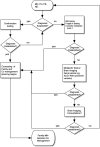Comprehensive evaluation of the child with intellectual disability or global developmental delays
- PMID: 25157020
- PMCID: PMC9923626
- DOI: 10.1542/peds.2014-1839
Comprehensive evaluation of the child with intellectual disability or global developmental delays
Abstract
Global developmental delay and intellectual disability are relatively common pediatric conditions. This report describes the recommended clinical genetics diagnostic approach. The report is based on a review of published reports, most consisting of medium to large case series of diagnostic tests used, and the proportion of those that led to a diagnosis in such patients. Chromosome microarray is designated as a first-line test and replaces the standard karyotype and fluorescent in situ hybridization subtelomere tests for the child with intellectual disability of unknown etiology. Fragile X testing remains an important first-line test. The importance of considering testing for inborn errors of metabolism in this population is supported by a recent systematic review of the literature and several case series recently published. The role of brain MRI remains important in certain patients. There is also a discussion of the emerging literature on the use of whole-exome sequencing as a diagnostic test in this population. Finally, the importance of intentional comanagement among families, the medical home, and the clinical genetics specialty clinic is discussed.
Copyright © 2014 by the American Academy of Pediatrics.
Figures

Similar articles
-
Updates in the genetic evaluation of the child with global developmental delay or intellectual disability.Semin Pediatr Neurol. 2012 Dec;19(4):173-80. doi: 10.1016/j.spen.2012.09.004. Semin Pediatr Neurol. 2012. PMID: 23245550 Review.
-
A clinical approach to developmental delay and intellectual disability.Clin Med (Lond). 2017 Dec;17(6):558-561. doi: 10.7861/clinmedicine.17-6-558. Clin Med (Lond). 2017. PMID: 29196358 Free PMC article. Review.
-
Medical genetics diagnostic evaluation of the child with global developmental delay or intellectual disability.Curr Opin Neurol. 2008 Apr;21(2):117-22. doi: 10.1097/WCO.0b013e3282f82c2d. Curr Opin Neurol. 2008. PMID: 18317267 Review.
-
The diagnostic yield of genetic and metabolic investigations in syndromic and nonsyndromic patients with autism spectrum disorder, global developmental delay, or intellectual disability from a dedicated neurodevelopmental disorders genetics clinic.Am J Med Genet A. 2024 Nov;194(11):e63791. doi: 10.1002/ajmg.a.63791. Epub 2024 Jun 20. Am J Med Genet A. 2024. PMID: 39031819
-
Diagnostic approach with genetic tests for global developmental delay and/or intellectual disability: Single tertiary center experience.Ann Hum Genet. 2019 May;83(3):115-123. doi: 10.1111/ahg.12294. Epub 2018 Nov 6. Ann Hum Genet. 2019. PMID: 30402882
Cited by
-
Relationship between fundamental motor skills and physical fitness in children with global developmental delay.Pediatr Investig. 2024 Sep 19;8(3):201-208. doi: 10.1002/ped4.12452. eCollection 2024 Sep. Pediatr Investig. 2024. PMID: 39347524 Free PMC article.
-
A 10-Year Review on Advancements in Identifying and Treating Intellectual Disability Caused by Genetic Variations.Genes (Basel). 2024 Aug 24;15(9):1118. doi: 10.3390/genes15091118. Genes (Basel). 2024. PMID: 39336708 Free PMC article. Review.
-
Quantifying attention in children with intellectual and developmental disabilities through multicenter electrooculogram signal analysis.Sci Rep. 2024 Sep 27;14(1):22186. doi: 10.1038/s41598-024-70304-x. Sci Rep. 2024. PMID: 39333619 Free PMC article.
-
Survey of the Landscape of Society Practice Guidelines for Genetic Testing of Neurodevelopmental Disorders.Ann Neurol. 2024 Nov;96(5):900-913. doi: 10.1002/ana.27045. Epub 2024 Sep 25. Ann Neurol. 2024. PMID: 39319594 Review.
-
Case report: Second report of neuromuscular syndrome caused by biallelic variants in ASCC3.Front Genet. 2024 Sep 2;15:1382275. doi: 10.3389/fgene.2024.1382275. eCollection 2024. Front Genet. 2024. PMID: 39286456 Free PMC article.
References
-
- Moeschler JB , Shevell M American Academy of Pediatrics Committee on Genetics . Clinical genetic evaluation of the child with mental retardation or developmental delays. Pediatrics. 2006;117(6):2304–2316 - PubMed
-
- Johnson CP , Myers SM American Academy of Pediatrics Council on Children With Disabilities . Identification and evaluation of children with autism spectrum disorders. Pediatrics. 2007;120(5):1183–1215 - PubMed
-
- Lopez-Rangel E , Mickelson E , Lewis MES . The value of a genetic diagnosis for individuals with intellectual disabilities: optimising healthcare and function across the lifespan. Br J Dev Disabil. 2008;54(107 pt 2):69–82
-
- Ronen GM , Fayed N , Rosenbaum PL . Outcomes in pediatric neurology: a review of conceptual issues and recommendations. The 2010 Ronnie Mac Keith Lecture. Dev Med Child Neurol. 2011;53(4):305–312 - PubMed
Publication types
MeSH terms
Grants and funding
LinkOut - more resources
Full Text Sources
Other Literature Sources
Medical

